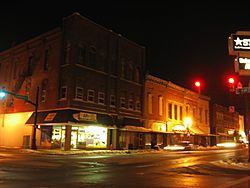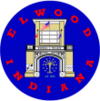Elwood, Indiana facts for kids
Quick facts for kids
City of Elwood
|
|||
|---|---|---|---|

Elwood Downtown Historic District at night
|
|||
|
|||

Location in Madison County and Tipton County, Indiana
|
|||
| Country | United States | ||
| State | Indiana | ||
| Counties | Madison, Tipton | ||
| Townships | Pipe Creek, Duck Creek, Madison | ||
| Area | |||
| • Total | 3.97 sq mi (10.28 km2) | ||
| • Land | 3.97 sq mi (10.28 km2) | ||
| • Water | 0.00 sq mi (0.00 km2) | ||
| Elevation | 863 ft (263 m) | ||
| Population
(2020-)
|
|||
| • Total | 8,410 | ||
| • Density | 2,119.46/sq mi (818.35/km2) | ||
| Time zone | UTC-5 (EST) | ||
| • Summer (DST) | UTC-4 (EDT) | ||
| ZIP code |
46036
|
||
| Area code(s) | 765 | ||
| FIPS code | 18-21070 | ||
| GNIS feature ID | 2394680- | ||
Elwood is a city in Madison and Tipton counties in the U.S. state of Indiana. The Madison County portion, which is nearly all of the city, is part of the Indianapolis–Carmel–Anderson metropolitan statistical area. The population of Elwood was 8,410 at the 2020 census.
Contents
History
Elwood was laid out in 1853 under the name "Duck Creek". It was incorporated as a city in 1891.
A post office was established under the name "Duck Creek" in 1855, was renamed to Elwood in 1869, and has been operating since. The first railroad was constructed in Elwood in 1857.
On August 17, 1940, the Republican National Committee held a formal notification ceremony to recognize Elwood-born Wendell Willkie as its nominee for President of the United States to run against Franklin Roosevelt. Held at Callaway Park on the outskirts of town, the ceremony drew 150,000 people for what would become the largest political rally in American history at the time. People came in 60,000 automobiles, 63 special trains, 300 Pullmans, and 1,200 buses. The Indiana University band led a parade in which 249 other bands also marched in the procession. When Willkie stepped onto the platform, the crowd cheered him for ten minutes before he could begin his speech. However, oppressive heat and Willkie's underwhelming, flat speech left many disappointed by the end of the day.
Sundown town
By the 1880s, Elwood had become a sundown town, prohibiting Black people from residing within the town. In 1897, when a number of Black families attempted to settle in the town and were driven out, The Evening Times in Washington, D.C., reported that for more than two decades Black people had not been "permitted to remain any length of time." This prohibition remained in place for most of the 20th century.
At the rally for Wendell Willkie, noted above, which drew around 150,000 people to the city, some prominent Black reporters, such as Marse Callaway of Baltimore, were allowed to briefly stay in a hotel downtown, but others were unable to stay the night due to the community's sundown status. Other Black people were discouraged from attempting to attend the rally at all due to the sundown signs posted at the city limits. These signs and policies remained in place for decades afterwards.
By the late twentieth century sundown policies were less strictly enforced, although as recently as 2002 law enforcement in nearby Marion considered Elwood to still be unwelcoming of Black people. In 2015, after Goshen, Indiana, passed a resolution acknowledging its history as a sundown town, Elwood's own past became a topic of discussion. The mayor of Elwood stated that while he had had no knowledge of the racially exclusionary policies of Elwood's past, he would address them if they were part of Elwood's "lingering reputation".
Geography
Elwood is located in northwestern Madison County. The equivalent of two half-blocks of land in Tipton County are also within the city limits.
Indiana State Road 28 passes through the city as Main Street, leading east 9 miles (14 km) to Alexandria and west 10 miles (16 km) to Tipton. State Road 13 (Anderson Street) crosses SR 28 in the center of Elwood; it leads north 10 miles (16 km) to Point Isabel and south 15 miles (24 km) to Lapel. State Road 37 crosses the southeast corner of the city limits, leading northeast 23 miles (37 km) to Marion and southwest 20 miles (32 km) to Noblesville. Anderson, the Madison county seat, is 17 miles (27 km) southeast of Elwood by local roads.
According to the U.S. Census Bureau, Elwood has a total area of 3.97 square miles (10.28 km2), all land. Big Duck Creek flows through the center of town, leading southwest to the White River near Strawtown.
Climate
| Climate data for Elwood, IN (1981-2013 normals-Extremes 1948–2013) | |||||||||||||
|---|---|---|---|---|---|---|---|---|---|---|---|---|---|
| Month | Jan | Feb | Mar | Apr | May | Jun | Jul | Aug | Sep | Oct | Nov | Dec | Year |
| Record high °F (°C) | 69 (21) |
74 (23) |
84 (29) |
88 (31) |
94 (34) |
99 (37) |
103 (39) |
99 (37) |
101 (38) |
92 (33) |
83 (28) |
72 (22) |
103 (39) |
| Mean maximum °F (°C) | 56 (13) |
61 (16) |
74 (23) |
81 (27) |
87 (31) |
92 (33) |
94 (34) |
93 (34) |
90 (32) |
82 (28) |
71 (22) |
58 (14) |
94 (34) |
| Mean daily maximum °F (°C) | 33.7 (0.9) |
38.2 (3.4) |
49.7 (9.8) |
62.2 (16.8) |
72.7 (22.6) |
81.4 (27.4) |
84.5 (29.2) |
83.0 (28.3) |
77.1 (25.1) |
64.6 (18.1) |
51.7 (10.9) |
37.7 (3.2) |
61.4 (16.3) |
| Daily mean °F (°C) | 25.0 (−3.9) |
29.4 (−1.4) |
39.2 (4.0) |
50.3 (10.2) |
61.1 (16.2) |
70.2 (21.2) |
73.4 (23.0) |
71.4 (21.9) |
64.6 (18.1) |
52.5 (11.4) |
41.5 (5.3) |
29.7 (−1.3) |
50.7 (10.4) |
| Mean daily minimum °F (°C) | 16.5 (−8.6) |
20.4 (−6.4) |
28.7 (−1.8) |
38.4 (3.6) |
49.7 (9.8) |
59.0 (15.0) |
62.3 (16.8) |
59.7 (15.4) |
52.0 (11.1) |
40.5 (4.7) |
31.9 (−0.1) |
21.6 (−5.8) |
40.1 (4.5) |
| Mean minimum °F (°C) | −4 (−20) |
−1 (−18) |
12 (−11) |
24 (−4) |
35 (2) |
46 (8) |
51 (11) |
48 (9) |
37 (3) |
27 (−3) |
18 (−8) |
2 (−17) |
−4 (−20) |
| Record low °F (°C) | −24 (−31) |
−23 (−31) |
−10 (−23) |
12 (−11) |
26 (−3) |
36 (2) |
43 (6) |
37 (3) |
28 (−2) |
17 (−8) |
−5 (−21) |
−20 (−29) |
−24 (−31) |
| Average precipitation inches (mm) | 2.49 (63) |
2.17 (55) |
3.00 (76) |
3.78 (96) |
4.24 (108) |
4.45 (113) |
4.33 (110) |
3.50 (89) |
3.50 (89) |
2.98 (76) |
3.96 (101) |
3.23 (82) |
41.63 (1,058) |
| Average snowfall inches (cm) | 5.0 (13) |
4.8 (12) |
1.1 (2.8) |
trace | 0.0 (0.0) |
0.0 (0.0) |
0.0 (0.0) |
0.0 (0.0) |
0.0 (0.0) |
trace | 0.1 (0.25) |
4.8 (12) |
15.8 (40.05) |
| Average extreme snow depth inches (cm) | 2 (5.1) |
4 (10) |
1 (2.5) |
0 (0) |
0 (0) |
0 (0) |
0 (0) |
0 (0) |
0 (0) |
0 (0) |
0 (0) |
2 (5.1) |
4 (10) |
| Average precipitation days (≥ 0.01 Inches) | 10 | 8 | 11 | 11 | 12 | 10 | 10 | 8 | 8 | 9 | 11 | 11 | 119 |
| Average snowy days (≥ 0.1 Inches) | 4 | 3 | 1 | 0 | 0 | 0 | 0 | 0 | 0 | 0 | 0 | 3 | 11 |
| Source: NOAA | |||||||||||||
Demographics
| Historical population | |||
|---|---|---|---|
| Census | Pop. | %± | |
| 1870 | 310 | — | |
| 1880 | 751 | 142.3% | |
| 1890 | 2,284 | 204.1% | |
| 1900 | 12,950 | 467.0% | |
| 1910 | 11,028 | −14.8% | |
| 1920 | 10,790 | −2.2% | |
| 1930 | 10,685 | −1.0% | |
| 1940 | 10,913 | 2.1% | |
| 1950 | 11,362 | 4.1% | |
| 1960 | 11,793 | 3.8% | |
| 1970 | 11,196 | −5.1% | |
| 1980 | 10,867 | −2.9% | |
| 1990 | 9,494 | −12.6% | |
| 2000 | 9,737 | 2.6% | |
| 2010 | 8,614 | −11.5% | |
| 2020 | 8,410 | −2.4% | |
| U.S. Decennial Census | |||
2010 census
As of the census of 2010, there were 8,614 people, 3,455 households, and 2,265 families living in the city. The population density was 2,284.9 inhabitants per square mile (882.2/km2). There were 4,099 housing units at an average density of 1,087.3 per square mile (419.8/km2). The racial makeup of the city was 96.7% White, 0.2% African American, 0.2% Native American, 0.3% Asian, 1.0% from other races, and 1.5% from two or more races. Hispanic or Latino of any race were 3.3% of the population.
There were 3,455 households, of which 33.1% had children under the age of 18 living with them, 44.8% were married couples living together, 14.8% had a female householder with no husband present, 6.0% had a male householder with no wife present, and 34.4% were non-families. 28.6% of all households were made up of individuals, and 12.5% had someone living alone who was 65 years of age or older. The average household size was 2.49 and the average family size was 3.02.
The median age in the city was 38.6 years. 25.2% of residents were under the age of 18; 8.5% were between the ages of 18 and 24; 24.1% were from 25 to 44; 28.1% were from 45 to 64; and 14.1% were 65 years of age or older. The gender makeup of the city was 48.7% male and 51.3% female.
Community and culture
The annual Glass Festival, held every third weekend of August, is one way in which the city tries to promote the area's history with natural gas and glass. In the years surrounding the turn of the century, Elwood, along with the nearby towns of Anderson and Gas City, were a common destination for Welsh immigrant families.
Elwood has a public library, a branch of the North Madison County Public Library System.
The Elwood Downtown Historic District was listed in the National Register of Historic Places in 2002.
Notable people
- David Canary, actor
- Jared Carter, poet
- Joseph Clancy, 24th director of the U.S. Secret Service
- James J. Davis, U.S. Secretary of Labor and U.S. senator from Pennsylvania
- Ryan Keene (aka "Fry Guy"), computer hacker
- Don Mellett, newspaper editor
- John Mengelt, professional athlete, NBA
- Philip Sharp, congressman from Indiana
- Ray Still, contemporary classical oboist
- Wallace D. Wattles, writer
- Edward Willkie, Olympic wrestler
- Wendell Willkie, 1940 Republican presidential candidate
See also
 In Spanish: Elwood (Indiana) para niños
In Spanish: Elwood (Indiana) para niños



